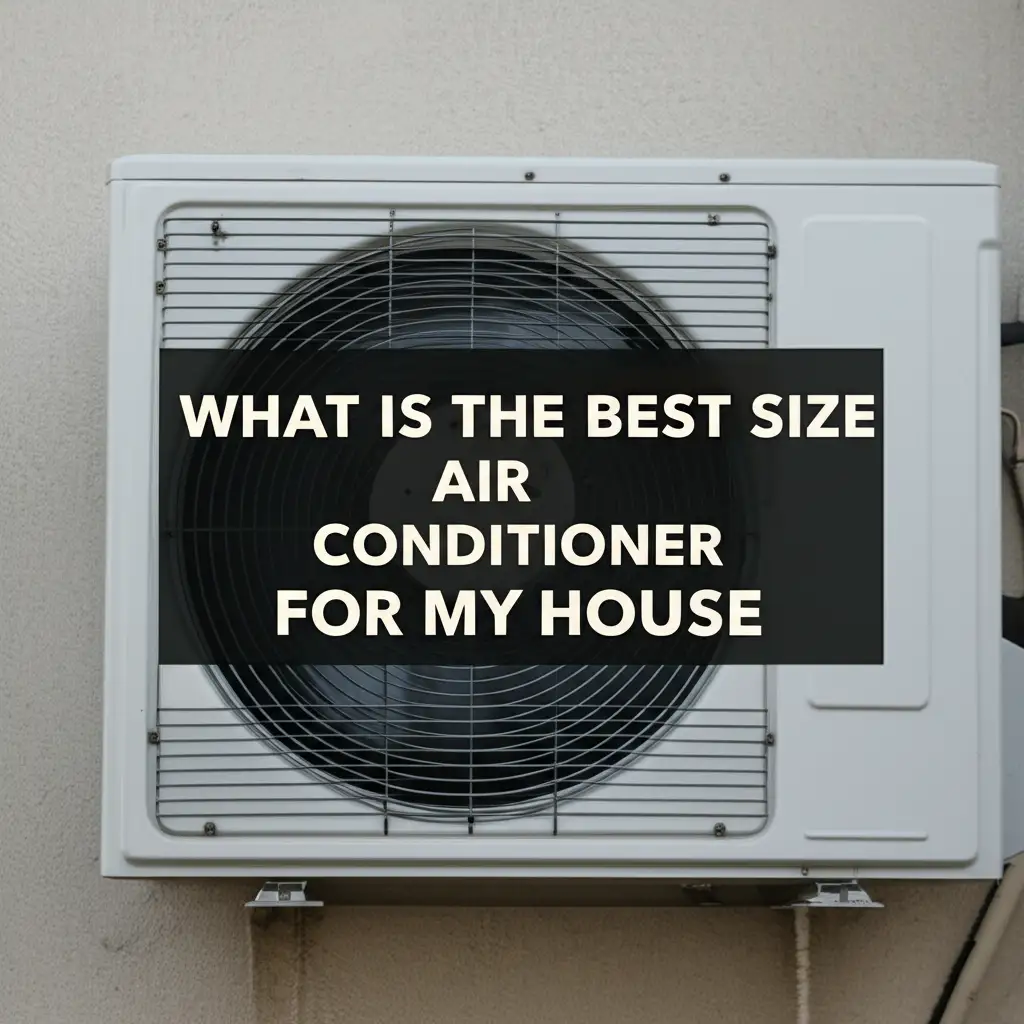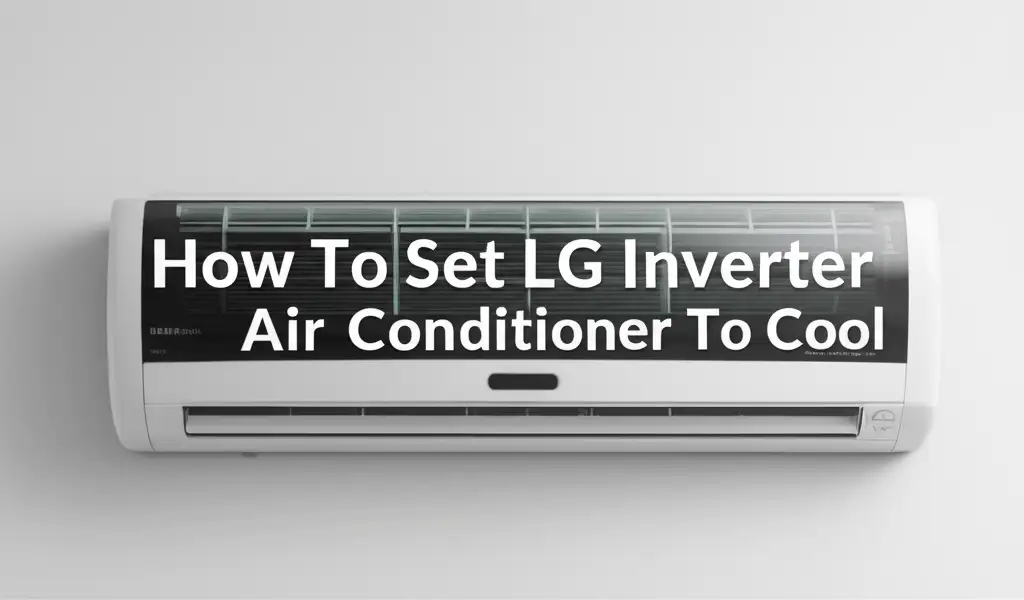· Katria Melrose · Home Appliances · 24 min read
What Is The Best Size Air Conditioner For My House

Find The Best AC Size For Your Home
Is your air conditioner struggling to cool your home? Or perhaps it runs constantly, making your energy bills skyrocket? Many homeowners face these issues. Often, the problem is not the AC unit’s quality, but its size. Choosing the best size air conditioner for your house is a critical decision.
An air conditioner that is too small cannot cool your space effectively. One that is too large cools too quickly, leading to other problems. Finding the right balance ensures comfort, efficiency, and lower costs. I will guide you through understanding AC sizing. You will learn key factors that affect cooling needs. We will also cover how professionals determine the perfect fit for your house. This article helps you make an informed choice for lasting home comfort.
Takeaway: Get the Right AC Size
- BTUs are key: AC size is measured in British Thermal Units (BTUs). Higher BTUs mean more cooling power.
- Avoid extremes: An AC too small or too large causes problems. Too small means poor cooling. Too large means short cycles and humidity issues.
- Consider all factors: House size, insulation, windows, climate, and more impact the right size.
- Professional calculation: A Manual J load calculation provides the most accurate sizing. This is best done by an HVAC expert.
- Efficiency matters: A correctly sized unit works more efficiently. This saves money on energy bills and extends unit life.
Determining the best size air conditioner for your house involves calculating its specific cooling load. This load depends on factors like square footage, insulation, window types, local climate, and ceiling height. An accurately sized unit ensures optimal comfort, energy efficiency, and proper humidity control without unnecessary wear on the system.
Understanding AC Sizing: What Are BTUs and Tonnage?
When you look for an air conditioner, you will see terms like BTUs and tonnage. These terms describe the cooling power of the unit. British Thermal Units (BTUs) measure how much heat an AC can remove from a space in one hour. For instance, a 10,000 BTU unit removes 10,000 BTUs of heat per hour. This is a direct measure of its cooling capacity.
Tonnage is another common term in HVAC. One ton of cooling capacity equals 12,000 BTUs per hour. This historical term relates to the amount of heat needed to melt one ton of ice in 24 hours. So, a 3-ton air conditioner provides 36,000 BTUs of cooling. Knowing these terms helps you compare different units. It is the first step in understanding what size air conditioner your house needs.
How BTUs Relate to Cooling Power
More BTUs mean a more powerful air conditioner. A small window unit might offer 5,000 BTUs. A large central air system can easily exceed 60,000 BTUs (5 tons). Choosing the correct BTU rating is vital. It directly impacts how well your home stays cool. An AC with too few BTUs will not cool your home adequately. It will run constantly, struggling to reach your desired temperature.
On the other hand, an AC with too many BTUs is also problematic. It will cool your home too fast. This might sound good, but it leads to other issues we will discuss. The goal is to match the BTU output to your home’s exact cooling needs. This ensures your system runs efficiently and provides consistent comfort. I always advise homeowners to prioritize this match for long-term satisfaction.
Common Misconceptions About AC Sizing
Many people think a bigger AC is always better. This is a common and costly mistake. A larger unit costs more to buy. It also uses more electricity when it runs. Beyond cost, an oversized AC cycles on and off too frequently. This is called “short cycling.” Short cycling prevents the unit from running long enough to properly dehumidify the air.
High humidity makes a home feel clammy and uncomfortable, even at a cool temperature. It also creates a favorable environment for mold growth. An undersized unit, as mentioned, will run non-stop. This causes high energy bills and excessive wear on the system. It shortens the lifespan of your air conditioner. Proper sizing is about finding the sweet spot. It ensures both comfort and energy efficiency. You can learn more about how to choose the right size air conditioner for your home to avoid these common pitfalls.
Why Proper Sizing Matters: Avoiding Costly Mistakes
The size of your air conditioner impacts your comfort and wallet. An AC unit that is too large or too small can cause significant problems. I have seen homeowners deal with these issues many times. Understanding why proper sizing is important saves you money and stress in the long run. It ensures your home remains a comfortable sanctuary from the heat.
Consider the consequences of getting the size wrong. These mistakes can lead to higher energy bills, uncomfortable living spaces, and premature equipment failure. My goal is to help you avoid these common pitfalls entirely. I want you to feel confident in your AC choice.
The Pitfalls of an Oversized Air Conditioner
An oversized air conditioner has too much cooling capacity for your home. It cools your living space very quickly. This might seem like a good thing at first. However, it leads to “short cycling.” Short cycling means the AC turns on, cools the space rapidly, and then shuts off. It does not run long enough to remove humidity from the air.
High indoor humidity causes a sticky, uncomfortable feeling. It also promotes the growth of mold and mildew. This can affect indoor air quality and cause health issues. An oversized unit also consumes more electricity each time it starts up. This frequent starting and stopping wears down components faster. You end up with higher energy bills and a shorter lifespan for your expensive equipment. An oversized AC does not provide truly comfortable cooling. It often leads to colder, damper spots instead of even comfort.
The Problems with an Undersized Air Conditioner
An undersized air conditioner cannot meet your home’s cooling demands. It will run almost constantly during hot weather. This continuous operation strains the system’s components. It works hard but fails to bring your home to the desired temperature. This leads to higher energy consumption and significantly increased electricity bills.
The constant running also means accelerated wear and tear on the unit. This can result in frequent breakdowns and the need for earlier replacement. You will never feel truly cool or comfortable in your home. The AC simply cannot keep up. Moreover, an undersized unit often fails to dehumidify effectively, even though it runs all the time. This makes your home feel clammy. It is a frustrating situation that costs you comfort and money.
The Benefits of a Properly Sized AC
A properly sized air conditioner provides several important benefits. First, it ensures consistent and comfortable temperatures throughout your home. The unit cycles on and off at appropriate intervals. This allows it to cool the air and remove humidity effectively. You will experience even cooling without hot or cold spots. Second, a correctly sized AC operates at peak energy efficiency.
It runs just enough to maintain your desired temperature. This minimizes energy waste and lowers your utility bills. Third, proper sizing extends the lifespan of your unit. It reduces wear and tear from short cycling or continuous operation. This means fewer repairs and a longer service life for your investment. Finally, optimal sizing maintains healthy indoor air quality. It manages humidity levels, which prevents mold and dust mite growth. Knowing how to figure out what size central air conditioner you need is crucial for these benefits.
Key Factors Influencing AC Size Selection
Choosing the best size air conditioner for your house involves more than just guessing. Many specific factors influence how much cooling power your home needs. Ignoring these elements can lead to an AC that works poorly. I consider each of these points carefully when advising clients. My goal is to help you understand them too.
These factors make your home unique. They all contribute to your home’s “heat load.” This is the total amount of heat that enters your home and needs removal. By understanding these points, you can appreciate the complexity of accurate AC sizing.
Square Footage of Your Home
The most basic factor for AC sizing is the square footage of your living space. More space requires more cooling power. A general rule of thumb suggests approximately 20 BTUs per square foot. For example, a 1,500 square foot home might need around 30,000 BTUs (2.5 tons). However, this is just a starting point. It is a very rough estimate and should not be your only guide.
Other factors significantly adjust this initial estimate. Relying solely on square footage often leads to incorrect sizing. I use this as a preliminary guide. Then I dig deeper into your home’s specific characteristics. This ensures the calculation is precise.
Climate and Local Weather Conditions
The climate where you live greatly impacts your cooling needs. Homes in hot, humid climates require more powerful AC units. They need to handle both high temperatures and significant moisture removal. A home in Phoenix, Arizona, will need a larger AC than a similar-sized home in Seattle, Washington. The number of extreme heat days also plays a role. If your summers are mild, you might need less cooling capacity.
Conversely, if heat waves are common, you need an AC that can keep up. My advice always includes considering your specific geographic location and its typical weather patterns. This ensures your AC can handle the peak demands of your local climate.
Insulation and Window Quality
Your home’s insulation acts like a thermal blanket. Good insulation keeps heat out in summer and heat in during winter. A well-insulated home loses less cool air. This means it needs a smaller AC unit. Homes with poor insulation, on the other hand, will leak cool air. They will also let more heat in. Such homes require more cooling capacity to maintain comfort.
Window quality is also critical. Old, single-pane windows let a lot of heat into your home. Energy-efficient, double-pane, or low-emissivity (low-E) windows block heat transfer. The number and size of your windows matter too. Large, south-facing windows allow significant solar gain. This means they let in a lot of sun and heat. All these factors change your home’s overall cooling load. You can often improve your home’s energy efficiency before upsizing your AC unit.
Ceiling Height and Number of Occupants
Taller ceilings increase the volume of air in a room. A room with 10-foot ceilings has more air to cool than one with 8-foot ceilings, even if the square footage is the same. This means higher ceilings often require more cooling capacity. It increases the overall heat load for the space.
The number of people living in your home also adds to the heat load. Each person generates body heat. A large family will produce more heat than a single occupant. This human heat must be removed by the AC. Homes with many occupants often need a slightly larger AC unit to compensate. Consider how many people regularly occupy your home. This helps fine-tune the AC size.
Appliances and Heat-Generating Sources
Every appliance in your home generates some heat. Large appliances like refrigerators, ovens, and clothes dryers produce significant heat. Computers, televisions, and even light bulbs also contribute. A kitchen that is frequently used for cooking will have a higher heat load. This added heat must be factored into your AC sizing calculation.
If you have many heat-generating appliances, especially in open-concept areas, your cooling needs increase. Think about how often you use these appliances. Consider if any specific areas in your home are prone to excess heat. All these elements contribute to the overall demand on your air conditioning system.
The Manual J Load Calculation: The Gold Standard
You might have heard about simply multiplying your square footage by a certain BTU number. This is a very rough estimate and often leads to incorrect AC sizing. The gold standard for determining the correct air conditioner size is the Manual J load calculation. This method is comprehensive. It accounts for all the factors specific to your home. I strongly recommend having this calculation done.
A Manual J calculation gives you the most accurate cooling load for your house. It ensures your new AC system is perfectly matched to your needs. This is a critical step that professionals rely on. It takes the guesswork out of AC sizing.
What is a Manual J Calculation?
A Manual J load calculation is a detailed engineering analysis. It determines how much heat your home gains from various sources. This includes external factors like sunlight through windows and heat through walls. It also accounts for internal heat sources. These include people, appliances, and lighting. The calculation follows specific guidelines set by the Air Conditioning Contractors of America (ACCA).
The output of a Manual J calculation is your home’s total cooling load. This is expressed in BTUs per hour. This precise number tells you the exact cooling capacity your AC system needs. It considers every detail of your home’s construction and layout. It is not just about size. It is about how your home interacts with heat.
How Professionals Perform a Manual J
An HVAC professional performs a Manual J calculation. They start by gathering detailed information about your home. This includes:
- Square footage and ceiling heights: Basic dimensions of each room and the entire house.
- Window specifications: Size, type (single-pane, double-pane, low-E), and orientation of all windows.
- Door types and sizes: How many, what material, and if they are insulated.
- Insulation levels: In walls, ceilings, and floors (R-value).
- Roofing material and color: Dark roofs absorb more heat than light ones.
- Climate zone: Your specific geographical location and its average temperatures.
- Number of occupants: The typical number of people living in the house.
- Major appliances: Large heat-generating appliances like ovens and refrigerators.
- Ductwork location: If ducts are in unconditioned spaces like attics.
The professional inputs this data into specialized software. The software then computes the precise heat gain for your home. This gives you an accurate BTU requirement. This detailed approach makes the Manual J calculation highly reliable. It removes all the guesswork from finding your ideal AC size. You can see why this is far superior to simple rule-of-thumb estimates.
Why You Should Insist on a Manual J
Insisting on a Manual J calculation provides many benefits. First, it guarantees proper sizing. This means your AC will run efficiently. It will provide optimal comfort. You will avoid the problems of both oversized and undersized units. Second, it saves you money on energy bills. An efficiently operating AC unit consumes less electricity. This translates to lower monthly costs.
Third, it prolongs the life of your AC system. When a unit is properly sized, it experiences less wear and tear. This reduces the need for frequent repairs. It also means your unit will last longer. Many manufacturers and energy efficiency programs now require a Manual J calculation for warranty validation or rebates. It is the smartest way to invest in your home’s cooling system. For detailed help, you should consult an expert on how to figure out what size central air conditioner you need.
DIY Estimates vs. Professional Assessment
When it comes to determining the best size air conditioner for your house, you have options. You can try a DIY estimate, or you can get a professional assessment. I always recommend the professional route for central air conditioning. However, it is good to understand both approaches. Each has its place depending on the complexity of your cooling needs.
For small, simple cooling solutions like a single window unit, a DIY estimate might suffice. But for your entire home’s central AC system, professional guidance is invaluable. It ensures you make the right long-term investment.
The Limitations of DIY Sizing Methods
Many online calculators offer quick AC sizing estimates. They usually ask for your square footage and climate zone. Some might ask about insulation or window types. While these tools give you a rough idea, they have significant limitations. They use generalized formulas. They cannot account for the unique details of your home. They do not consider specific insulation levels, window efficiency, or individual heat sources.
For example, a calculator might not differentiate between an old, drafty window and a new, energy-efficient one. It might not accurately assess solar gain. These DIY methods are a starting point at best. They are useful for initial research. They are not reliable for making a final purchase decision for a whole-house system. Relying solely on them can easily lead to a poorly sized AC.
When DIY Estimates Are Acceptable
DIY estimates can be acceptable for very specific situations. If you are buying a single window air conditioner for a small, isolated room, a simple square footage calculation might work. For instance, a 150-square-foot bedroom with standard windows. You can use a basic BTU per square foot rule. Even then, I would add a little extra BTU if the room gets a lot of sun.
For portable air conditioners, a quick estimate based on the room size is also often sufficient. These smaller units serve a limited area. The impact of slight miscalculations is less severe. However, for anything larger or more integrated, such as multi-zone mini-splits or central air systems, professional assessment becomes essential. You can find specific guidance on how to figure out what size window air conditioner you need if you are considering one of these.
The Value of a Professional HVAC Assessment
A professional HVAC contractor provides the most accurate assessment. They perform a Manual J load calculation, as discussed earlier. This detailed analysis takes into account all the specific characteristics of your home. They look at insulation values, window types and orientation, ceiling heights, and even the heat generated by your family and appliances.
A professional also considers the local climate. They can identify any unique challenges your home presents. For example, a home with a large, unshaded glass wall facing west. They use specialized software to get a precise BTU requirement. This level of detail is impossible to achieve with a simple online calculator. Investing in a professional assessment ensures your AC system is perfectly sized. It leads to optimal comfort, energy efficiency, and a longer lifespan for your equipment. I strongly recommend this for any whole-house AC installation.
Considering Your Home’s Unique Characteristics
Every home is different. What works for your neighbor might not work for you. Beyond the basic factors, some unique characteristics of your home can impact AC sizing. I always look at these specific details. They help fine-tune the recommendation for the best size air conditioner for your house.
These subtle differences can surprisingly affect your home’s overall heat gain or loss. Overlooking them can lead to minor, yet persistent, comfort issues. Paying attention to these specifics makes a big difference.
Direction Your Home Faces
The direction your home faces can significantly impact its heat gain. South-facing walls and windows receive the most direct sunlight throughout the day. West-facing windows get intense afternoon sun. This adds a lot of heat to your home. East-facing windows get morning sun, which is less intense. North-facing windows get minimal direct sun.
If your home has many large windows on the south or west side, it will experience more solar gain. This increases your cooling load. An AC unit might need to be slightly larger to handle this extra heat. Shading from trees or neighboring buildings can also reduce solar gain. This factor is crucial for precise sizing.
Presence of Large Trees or Shading
Large trees around your home provide natural shade. This shade can dramatically reduce the amount of direct sunlight hitting your walls and windows. Less direct sunlight means less heat enters your home. This can reduce your overall cooling load. A home with mature trees providing ample shade might need a slightly smaller AC unit compared to an identical home in direct sun.
Conversely, a home with no shading, especially from the afternoon sun, will experience higher heat gain. This requires more cooling power. When assessing your home, I always observe the surrounding landscape. The presence or absence of natural shade is a key factor. It directly affects how much work your AC system needs to do.
Type of Roofing Material and Color
Your roof absorbs a lot of solar heat. The type and color of your roofing material influence how much heat transfers into your attic and then into your living space. Dark-colored roofs absorb more sunlight. This makes your attic hotter and increases the heat gain into your home. Light-colored roofs or “cool roofs” reflect more sunlight. They keep your attic and home cooler.
If you have a dark roof, your AC system might need more capacity. If you have a light-colored or reflective roof, it could potentially reduce your cooling load. The attic ventilation also plays a role here. Proper attic ventilation helps expel hot air. This further reduces the heat load on your AC.
Number of Stories and Layout
The number of stories in your home and its layout also affect AC sizing. Heat rises. So, upper floors tend to be warmer than lower floors. A multi-story home might have different cooling needs on each floor. This can influence whether you need a single central AC or a multi-zone system.
An open-concept layout allows air to circulate more freely. This can sometimes make cooling more efficient. However, it also means heat can spread easily. A very compartmentalized home might have specific rooms that get hotter than others. These factors influence where to place ducts and registers. They also determine the overall capacity needed for each zone or the entire house.
Home Age and Construction Materials
Older homes often have different insulation standards compared to newer homes. They might have less insulation in walls and ceilings. They might have older, less efficient windows and doors. These older construction methods can lead to more air leakage. They can also mean greater heat transfer. This increases the cooling load.
Newer homes generally have better insulation and tighter construction. They are more energy-efficient by design. This means they often require less cooling capacity per square foot. The specific materials used in your home’s construction, such as brick, wood, or stucco, also affect heat transfer. A professional assessment considers the unique construction details of your home. This ensures the best AC size for your house.
Energy Efficiency and SEER Ratings
Once you determine the best size air conditioner for your house, the next step is to choose an energy-efficient model. The Seasonal Energy Efficiency Ratio (SEER) rating helps you compare different AC units. A higher SEER rating means a more efficient unit. This translates directly to lower energy bills and reduced environmental impact.
Understanding SEER ratings helps you make a smart investment. It ensures you not only have the right size but also the most cost-effective unit. I always discuss SEER ratings with homeowners. It is an important part of the decision-making process.
Understanding SEER and EER Ratings
SEER stands for Seasonal Energy Efficiency Ratio. It measures how efficiently an air conditioner converts electricity into cooling over an entire cooling season. A higher SEER rating indicates greater efficiency. For example, a 16 SEER unit is more efficient than a 13 SEER unit. The minimum SEER rating for new AC units varies by region. It is currently 13-14 SEER.
EER stands for Energy Efficiency Ratio. This measures the efficiency of an AC unit under specific test conditions. It is a snapshot of efficiency at a single operating point. SEER is generally more relevant for homeowners. It reflects overall performance in varying conditions. Both ratings provide insight into a unit’s energy consumption. My focus is usually on SEER. It gives a better picture of seasonal energy savings.
How SEER Ratings Impact Your Energy Bills
A higher SEER rating means your air conditioner uses less electricity to produce the same amount of cooling. This directly translates to lower energy bills. The initial cost of a higher SEER unit is often more expensive. However, the energy savings over the unit’s lifespan typically offset this extra cost. For example, upgrading from a 10 SEER unit to a 16 SEER unit can reduce cooling costs by 30-50%.
Over 10-15 years, these savings add up to thousands of dollars. The return on investment for a high-SEER unit is often significant. It depends on your local electricity rates and how much you use your AC. I encourage homeowners to consider the long-term savings. The upfront cost is an investment in future lower utility bills.
Variable-Speed Technology and SEER
Traditional AC units often have single-speed compressors. They are either fully on or fully off. This means they deliver maximum cooling capacity whenever they run. Variable-speed technology is more advanced. These units can adjust their compressor speed. They can run at lower capacities to maintain temperature. This avoids frequent on-off cycling.
Variable-speed units operate more continuously at lower speeds. This removes more humidity from the air. It also provides more consistent temperatures. This technology greatly improves comfort. It also achieves much higher SEER ratings, often 18 SEER or above. These units are more expensive initially. But they offer superior comfort and significant energy savings. They are a good choice for homeowners seeking peak efficiency and comfort.
Finding the Right Balance: Cost vs. Efficiency
Choosing an AC unit involves balancing initial cost with long-term energy savings. A higher SEER unit costs more to buy and install. A lower SEER unit is cheaper upfront. However, it costs more to operate each month. I advise homeowners to look at the total cost of ownership. This includes the purchase price, installation, and estimated energy costs over the unit’s lifespan.
Consider how long you plan to stay in your home. If you plan to stay for many years, investing in a higher SEER unit makes financial sense. The energy savings will accumulate. If you plan to move soon, a moderately efficient unit might be a better choice. Your local climate also plays a role. In very hot climates, a high-SEER unit offers greater savings due to extended use. Make sure your system stays efficient by learning how to clean air conditioner filter. Regular maintenance, like filter cleaning, helps maintain peak performance regardless of the SEER rating.
Seasonal Adjustments and Future Considerations
Even after you determine the best size air conditioner for your house, there are still considerations. Your home’s cooling needs can change over time. Seasonal adjustments and future planning are important for ongoing comfort and efficiency. I help homeowners think ahead. This ensures their AC system remains effective for years to come.
Thinking about future changes helps protect your investment. It also prepares you for unexpected shifts in your home’s needs. This proactive approach saves you time and money later on.
Impact of Renovations and Additions
Any major renovation or addition to your home can change your cooling needs. Adding new rooms, converting a garage, or enclosing a patio increases your home’s square footage. This directly increases the cooling load. If you add significant living space, your existing AC unit might become undersized. It will struggle to cool the larger area.
Similarly, improving your home’s insulation or replacing old windows can reduce your cooling load. Better insulation means less heat enters your home. This might allow a slightly smaller AC unit to perform effectively. If you plan major renovations, consult your HVAC professional. They can reassess your cooling needs. This ensures your AC system remains correctly sized for your updated home.
Adapting to Climate Change and Extreme Weather
Climate patterns are changing. Many regions experience hotter summers and more frequent heat waves. This trend means your home’s cooling demands might increase over time. When sizing your AC, consider these potential shifts in future weather. An AC system installed today needs to perform well for the next 10-15 years.
While you cannot predict exact future temperatures, understanding climate trends is helpful. You might consider sizing slightly above the bare minimum if your region is prone to increasingly severe heat. This provides a buffer for future extreme weather events. It helps ensure your home stays comfortable, even when temperatures climb higher than expected.
Maintaining Optimal Performance Over Time
Even a perfectly sized air conditioner needs proper maintenance to perform well. Regular maintenance ensures your unit continues to operate at its peak efficiency. This includes changing air filters regularly. Dirty filters restrict airflow. This makes the AC work harder. It reduces efficiency. I always advise homeowners to clean their air conditioner filters monthly during heavy use. You can find more information on how to clean air conditioner filter to keep your system in top shape.
Professional tune-ups are also crucial. An HVAC technician can inspect components, clean coils, and check refrigerant levels. These tasks keep your system running smoothly. Neglecting maintenance can cause your unit to lose efficiency. It might even lead to breakdowns. Proper maintenance helps your correctly sized AC deliver consistent comfort and savings for its entire lifespan. For more general advice on maintaining your AC unit, you can read about how to clean air conditioner.





